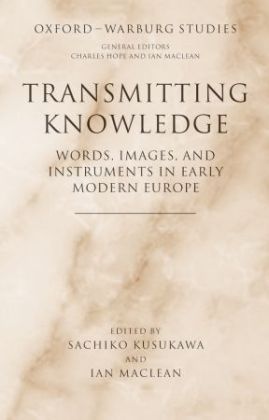En savoir plus
Zusatztext This collection of essays is a strong contribution to the growing literature integrating the history of science with the history of the book. Together, these essays show what is possible when historians take seriously the idea that early modern knowledge was embedded in material, social, cultural and economic contexts, and can only be fully understood in terms of the ways in which it was embodied in words, images and instruments. Informationen zum Autor Ian Maclean is a graduate of Oxford, where he also did his doctorate; he was for twenty-four years a Fellow and Praelector in French at Queen's College Oxford, and Lecturer then Reader in Modern Languages in the University of Oxford. He became a titular professor in Renaissance Studies in the University, before moving to All Souls as a Senior Research Fellow in History in 1996. He has held visiting fellowships in Australia, USA, Canada, France, the Netherlands and Germany. He is a Fellow of the British Academy, a Fellow of the Royal Historical Society, a Chevalier des arts et des lettres (France), and a member of the Academia Europaea. Klappentext Based on new research, a distinguished international team studies the forms in which scientific knowledge was transmitted in the late medieval and early modern period, the ways they interacted, and the people to whom the knowledge was directed. Among the famous authors whose work is examined here are Fuchs, Vesalius, Tycho Brahe, and Descartes. Zusammenfassung The period between the fifteenth and the middle of the seventeenth centuries saw a great many changes and innovations in scientific thinking. These were communicated to various publics in diverse ways; not only through discursive prose and formal notations, but also in the form of instruments and images accompanying texts. The collected essays of this volume examine the modes of transmission of this knowledge in a variety of contexts. The schematic representation of instruments is examined in the case of the 'navicula' (a versatile version of a sundial) and the 'squadro' (a surveying instrument); the new forms of illustration of plants and the human body are investigated through the work of Fuchs and Vesalius; theories of optics and of matter are discussed in relation to the illustrations which accompany the texts of Ausonio and Descartes. The different diagrammatic strategies adopted to explain the complex medical theory of the latitude of health are charted through the work of medieval and sixteenth-century physicians; Kepler's use of illustration in his handbook of cosmology is placed in the context of book production and Copernican propaganda. The conception of astronomical instruments as either calculating devices or as cosmological models is examined in the case of Tycho Brahe and others. A study is devoted to the multiple functions of frontispieces and to the various readerships for which they were conceived. The papers in the volume are all based on new research, and they constitute together a coherent and convergent set of case studies which demonstrate the vitality and inventiveness of early modern natural philosophers, and their awareness of the media available to them for transmitting knowledge. Inhaltsverzeichnis Introduction 1: Sven Dupré: Visualization in Renaissance Optics: The Function of Geometrical Diagrams and Pictures in the Transmission of Practical Knowledge 2: Catherine Eagleton: Medieval Sundials and Manuscript Sources: The Transmission of Information about the Navicula and the organum ptolomei in Fifteenth-Century Europe 3: Sachiko Kusukawa: The Uses of Pictures in the Formation of Learned Knowledge: The Cases of Leonhard Fuchs and Andreas Vesalius 4: Christopher Lüthy: Where Logical Necessity Becomes Visual Persuasion: Descartes's Clear and Distinct Illustrations 5: Ian Maclean: Diagrams in the Defence of Galen: Medical Uses of Tables, Squares, Dichotomies, Wheels, and ...

